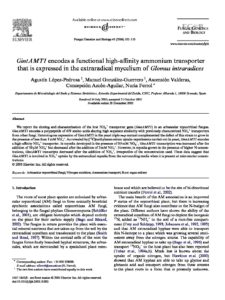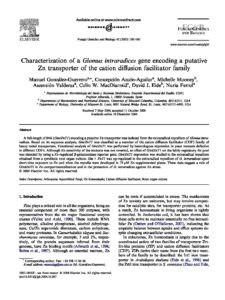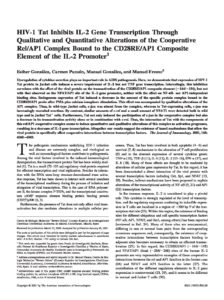Journal Article
Publication Types:

GintAMT1 encodes a functional high-affinity ammonium transporter that is expressed in the extraradical mycelium of Glomus intraradices
Abstract
We report the cloning and characterization of the first NH4+ transporter gene (GintAMT1) in an arbuscular mycorrhizal fungus. GintAMT1 encodes a polypeptide of 479 amino acids sharing high sequence similarity with previously characterized NH4+ transporters from other fungi. Heterologous expression of GintAMT1 in the yeast triple mep mutant complemented the defect of this strain to grow in the presence of less than 1 mM NH4+. As revealed by [14C]methylammonium uptake experiments carried out in yeast, GintAMT1 encodes a high-affinity NH4+ transporter. In mycelia developed in the presence of 0.9 mM NO3−, GintAMT1 transcription was increased after the addition of 30 μM NH4+ but decreased after the addition of 3 mM NH4+. However, in mycelia grown in the presence of higher N concentrations, GintAMT1 transcripts decreased after the addition of NH4+, irrespective of the concentration used. These data suggest that GintAMT1 is involved in NH4+ uptake by the extraradical mycelia from the surrounding media when it is present at micromolar concentrations.

Characterization of a Glomus intraradices gene encoding a putative Zn transporter of the cation difusión facilitator family
Abstract
A full-length cDNA (GintZnT1) encoding a putative Zn transporter was isolated from the extraradical mycelium of Glomus intraradices. Based on its sequence analysis, GintZnT1 was classified as a member of the cation diffusion facilitator (CDF) family of heavy metal transporters. Functional analysis of GintZnT1 was performed by heterologous expression in yeast mutants defective in different CDFs. Although Zn sensitivity of the mutants was not reverted, an effect of GintZnT1 on the labile regulatory Zn pool was detected by using a Zn-regulated β-galactosidase reporter gene. GintZnT1 expression was studied in the extraradical mycelium obtained from a symbiotic root organ culture. Gin ± ZnT1 was up-regulated in the extraradical mycelium of G. intraradices upon short-time exposure to Zn and when the mycelia were developed in 75 μM Zn supplemented plates. These data suggest a role of GintZnT1 in Zn compartmentalization and in the protection of G. intraradices against Zn stress.

HIV-1 Tat inhibits IL-2 gene transcription through qualitative and quantitative alterations of the cooperative Rel/AP1 complex bound to the CD28RE/AP1 composite element of the IL-2 promoter
Abstract
Dysregulation of cytokine secretion plays an important role in AIDS pathogenesis. Here, we demonstrate that expression of HIV-1 Tat protein in Jurkat cells induces a severe impairment of IL-2 but not TNF gene transcription. Interestingly, this inhibition correlates with the effect of the viral protein on the transactivation of the CD28RE/AP1 composite element (−164/−154), but not with that observed on the NFAT/AP1 site of the IL-2 gene promoter, neither with the effect on NF-κB- nor AP1-independent binding sites. Endogenous expression of Tat induced a decrease in the amount of the specific protein complex bound to the CD28RE/AP1 probe after PMA plus calcium ionophore stimulation. This effect was accompanied by qualitative alterations of the AP1 complex. Thus, in wild-type Jurkat cells, c-jun was absent from the complex, whereas in Tat-expressing cells, c-jun was increasingly recruited overtime. By contrast, similar amounts of c-rel and a small amount of NFAT1 were detected both in wild type and in Jurkat Tat+ cells. Furthermore, Tat not only induced the participation of c-jun in the cooperative complex but also a decrease in its transactivation activity alone or in combination with c-rel. Thus, the interaction of Tat with the components of this rel/AP1 cooperative complex seems to induce quantitative and qualitative alterations of this complex as activation progresses, resulting in a decrease of IL-2 gene transcription. Altogether our results suggest the existence of tuned mechanisms that allow the viral protein to specifically affect cooperative interactions between transcription factors.
